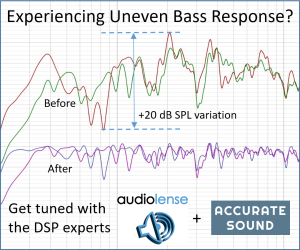1_sufferin_mind
Active Member
More
- Preamp, Processor or Receiver
- Emotiva XMC-2
- Main Amp
- Emotiva XPA-5
- Additional Amp
- McCormack DNA-1 Custom Monoblocks (On Standby)
- Other Amp
- Woo Audio WA6se w/ Audeze LCD-2
- Universal / Blu-ray / CD Player
- Oppo BDP-95
- Streaming Subscriptions
- JVC X70R Proj ; PS Audio PWD w/ Streaming Bridge
- Front Speakers
- Revel Ultima Salon
- Center Channel Speaker
- Revel Voice
- Surround Speakers
- PSB Image B5
- Subwoofers
- Seaton Sound Submersive F2+/- pair
- Other Speakers
- Cary SLP98P / VPI SuperScout with JMW9 & Hana MH
- Screen
- TBD
- Video Display Device
- LG 65" OLED 65CX
Linn includes a room correction system called Space Optimisation which does not use a micropone. Instead, the user enters room dimensions and any acoustic features like
The correction profile is then stored in the particular Linn audio product being used. And if your setup is less than ideal, Space Optimisation can compensate:
It's probably a long shot but do you have, or do you know anyone who has, personal experience with this room correction tool?
Do you think Space Optimisation could be as effective as Audyssey XT32 or Dirac Live - or for any microphone-based tool?
According to their literature,Enter the room dimensions into our on-screen tool—running on any computer or laptop—along with the construction type and any features, such as windows and doors that will affect the sound. Select your make and model of speakers, enter their location and where you’ll be sitting, and Space Optimisation will do the rest.
Space Optimisation creates an exceptionally detailed acoustic model of the room, then taking account of the specific characteristics of your speakers, it identifies exactly how to deliver the best sound to you.
The correction profile is then stored in the particular Linn audio product being used. And if your setup is less than ideal, Space Optimisation can compensate:
The acoustic model takes into account your chosen practical position for your speakers, and emulates the sound that you would have heard in the ideal location.
It's probably a long shot but do you have, or do you know anyone who has, personal experience with this room correction tool?
Do you think Space Optimisation could be as effective as Audyssey XT32 or Dirac Live - or for any microphone-based tool?















